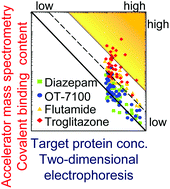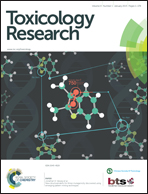Zone analysis by two-dimensional electrophoresis with accelerator mass spectrometry of in vivo protein bindings of idiosyncratic hepatotoxicants troglitazone and flutamide bioactivated in chimeric mice with humanized liver†
Abstract
Analyses using electrophoresis with accelerator mass spectrometry revealed that in vivo bioactivated radiolabeled troglitazone and flutamide, both known to be hepatotoxic in humans, bound nonspecifically to a variety of microsomal and cytosolic proteins in livers from chimeric mice with humanized liver. Unlike those of radiolabeled diazepam (rarely hepatotoxic) and previously reported 5-n-butyl-pyrazolo[1,5-a]pyrimidine (limited hepatotoxicity), some troglitazone and flutamide binding proteins were located in the top right area in a zone analysis, representing high covalent binding contents and high target protein concentrations. Among a variety of liver microsomal proteins bound, the binding target proteins of troglitazone and flutamide with the highest covalent binding contents (in terms of pmol equivalent per μg target protein) were 17β-hydroxysteroid dehydrogenase and 3β-hydroxysteroid dehydrogenase, respectively. Troglitazone and flutamide were activated to reactive metabolites and apparently bound to different target proteins in livers from chimeric mice with humanized liver. The highest covalent binding contents for troglitazone were higher than that for flutamide under the present conditions. These results indicate that the drug metabolism mediated by humanized livers (leading to binding in vivo) in combination with a zone analysis of covalent binding contents/target protein concentration data could be a good tool for evaluating the relationship between the nonspecific protein binding behavior of medicines and potential hepatotoxicity in humans. Thus, testing whether protein binding data of new medicines are unbalanced with respect to deviation from an inverse relationship or the presence of data points in the high covalent binding/high protein concentration zone might be an important concept in evaluating hepatotoxic potential.


 Please wait while we load your content...
Please wait while we load your content...